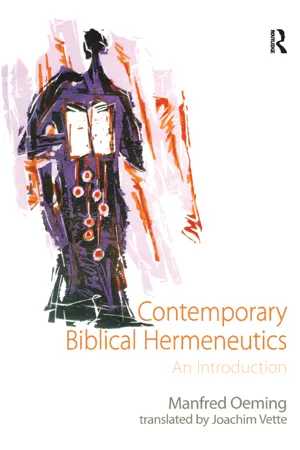
Contemporary Biblical Hermeneutics
An Introduction
- 182 pages
- English
- ePUB (mobile friendly)
- Available on iOS & Android
About This Book
Appearing in English for the first time, this classic introduction to the field of hermeneutics covers a wide range of approaches to biblical interpretation. Presenting a brief history of philosophical hermeneutics, Manfred Oeming uses a clear structure to emphasize why there are, and why there must be, different and differing approaches to the interpretation of a text, in this case particularly the biblical text. The often confusing multiplicity of approaches to biblical interpretation are introduced along accessible lines, concluding with an argument for an acceptance of a multiplicity of approaches to account for the many layers of the biblical text. Incorporating discussion of the German hermeneutical tradition, exemplified by the work of Heidegger, Bultmann, and Gadamer, this book helps to bridge Anglo-American and German scholarly traditions. It will be of great assistance to students, teachers and preachers.
Frequently asked questions
Information
Chapter 1
Introduction: The Topic and Procedure of this Book
PART I:
The Philosophical Foundations of Biblical Hermeneutics
Chapter 2
The Phenomenology of Understanding: The Theory of the Hermeneutical Square
Table of contents
- Cover
- Half Title
- Title Page
- Copyright Page
- Table of Contents
- List of Figures
- Preface
- 1 Introduction: The Topic and Procedure of this Book
- Part I: The Philosophical Foundations of Biblical Hermeneutics
- Part II: The Plurality of Current Approaches to the Bible
- Part III: Summary: Fullness or Food of Meaning?
- Bibliography
- Index A: Authors
- Index B: Biblical Names
- Index C: Scriptures